Key takeaways:
- Intersectionality in gender highlights the need to consider multiple identities (race, class, sexuality) that shape individual experiences and challenges within feminist movements.
- The evolution of feminist fashion reflects broader societal changes, emphasizing the importance of inclusivity, sustainability, and representation in fashion choices.
- Personal experiences with intersectional fashion showcase the connection between cultural identity and self-expression, as well as the need for broader acceptance of diverse styles.
- Advocating for diversity in fashion involves amplifying marginalized voices and supporting brands that celebrate equitable representation and ethical consumption.
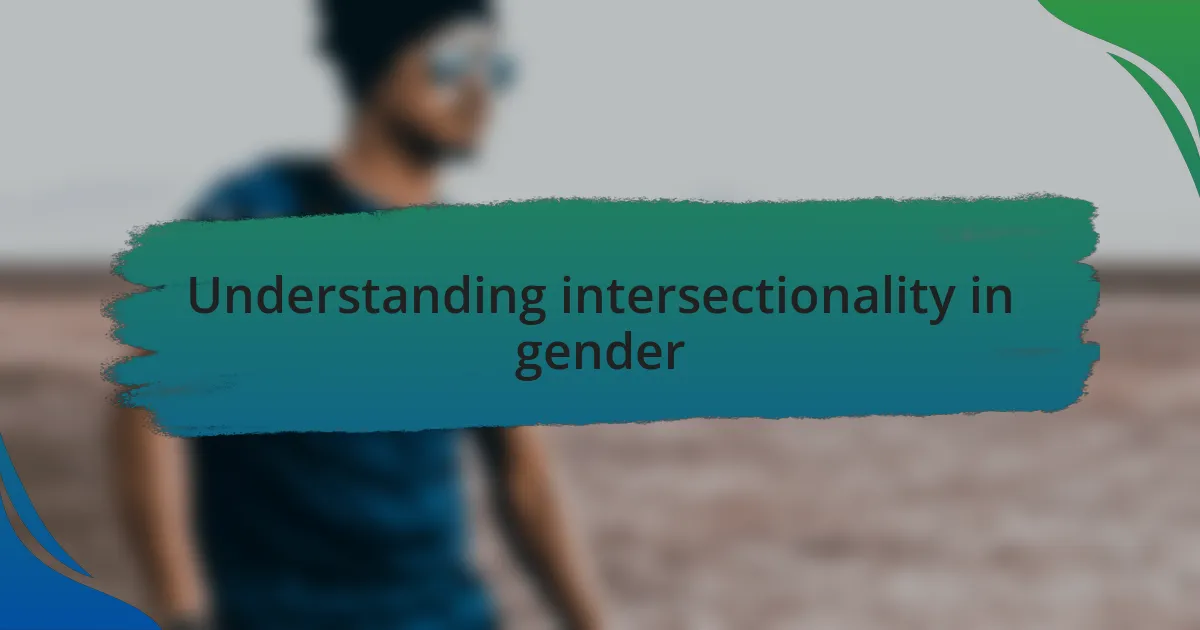
Understanding intersectionality in gender
Understanding intersectionality in gender involves recognizing that gender does not exist in a vacuum. Instead, it intersects with various identities like race, class, sexuality, and ability, which can shape individuals’ experiences differently. I once attended a panel discussion where a Black woman spoke about her struggles in both feminist and racial justice spaces. Her words resonated deeply with me, revealing how often voices are marginalized when multiple identities come into play.
I think about how often I’ve seen feminist movements focus on a singular narrative, often leaving out those who don’t fit the mold. How do we change that? We must actively listen to diverse perspectives and acknowledge that experiences vary widely. For instance, a queer woman of color may face challenges that a cisgender white woman simply may not understand. This disparity demands that we approach gender discussions with empathy and openness, truly reflecting the multiplicity of experiences.
Moreover, intersectionality invites us to analyze power structures within gender discussions. It’s not just about equality; it’s about equity. When I reflect on fashion and how it can empower or restrict, it’s clear that clothing can mean something entirely different for a plus-size transgender individual compared to someone who fits societal norms. How can we, as advocates of feminist fashion, ensure that we’re creating space for these nuanced conversations? By embracing intersectionality, we can elevate the dialogue to be more inclusive and impactful.
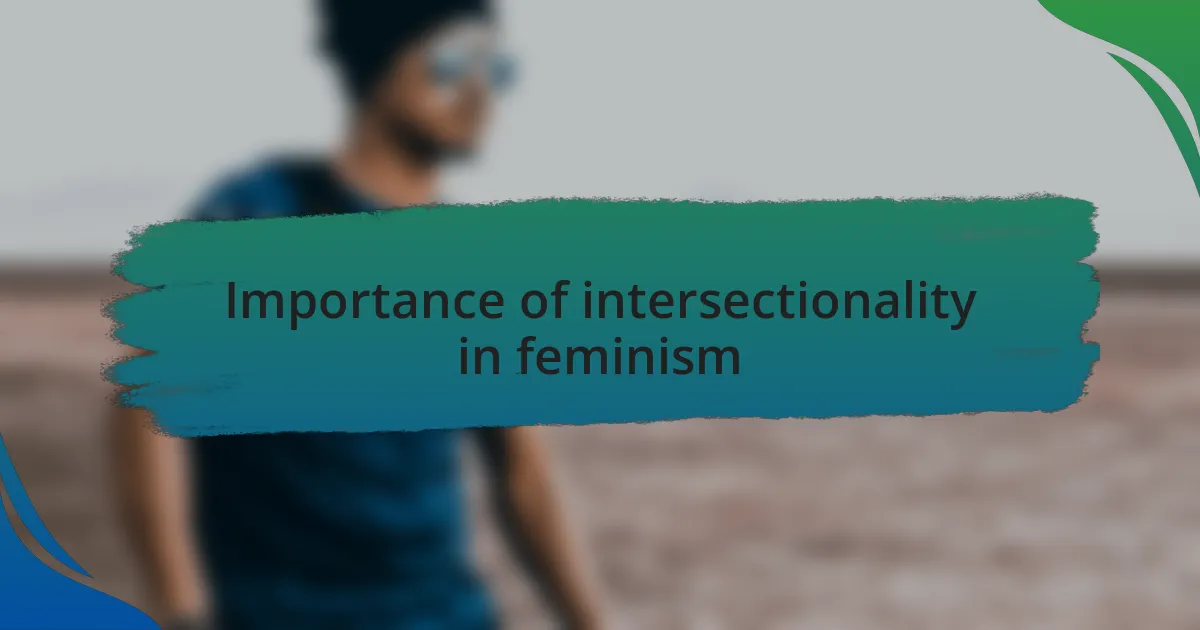
Importance of intersectionality in feminism
Intersectionality is crucial in feminism because it truly reflects the diversity of women’s experiences. I remember talking to a friend who identifies as a disabled woman; she shared how mainstream feminist conversations often overlook the unique challenges she faces. This made me realize that when we ignore such perspectives, we risk creating a one-size-fits-all narrative that doesn’t serve many.
Considering intersectionality also allows us to challenge systemic inequalities directly. I once participated in a workshop that highlighted how economic status affects access to resources for women. It struck me that a grassroots movement focused solely on gender equality might inadvertently ignore those who are economically disadvantaged. We have to ask ourselves: Can we really achieve equality if we leave those on the margins behind?
Finally, intersectionality enables a deeper understanding of solidarity among women. I think about the bonds that form when we share our diverse stories. These connections can lead to more powerful collective actions. So, how do we create safer spaces for dialogue? It starts with fostering an environment where every voice is valued and heard, prompting a more robust feminist movement that truly represents us all.
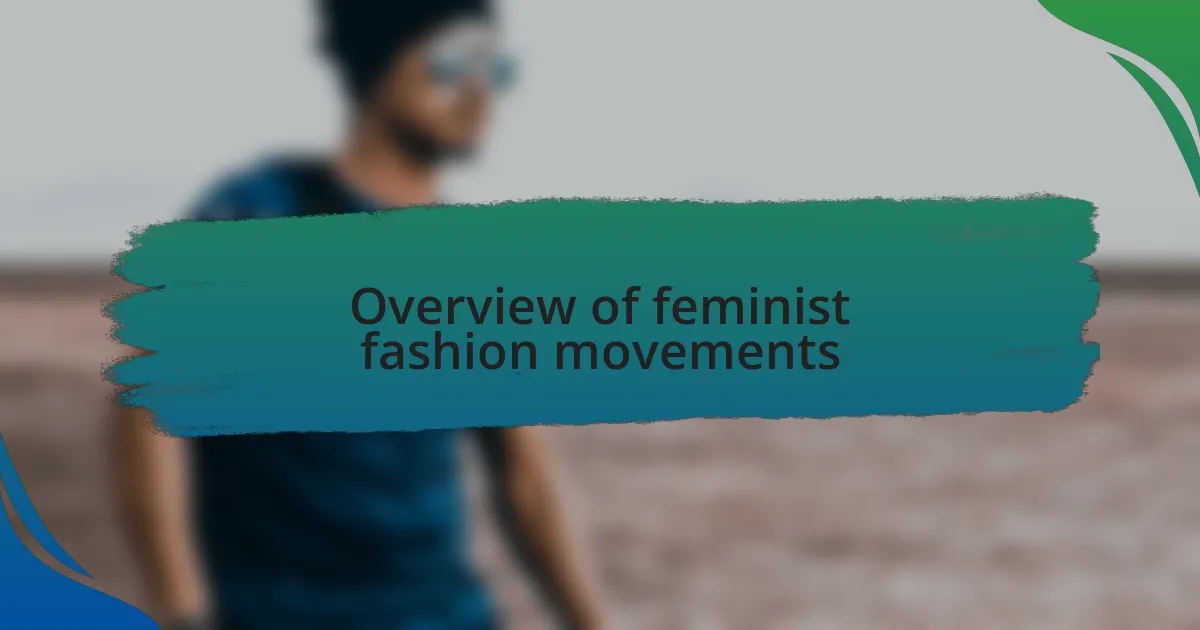
Overview of feminist fashion movements
Feminist fashion movements have evolved significantly over the decades, reflecting broader societal changes and women’s diverse experiences. I recall attending a local exhibit that showcased the power of fashion in the 1960s feminist movement. The bold statements made through clothing—like the iconic miniskirt—served as a literal declaration of freedom and self-expression, pushing against traditional gender norms.
In the 1980s, fashion began to intersect with various identity politics, especially as women of color and + individuals demanded representation. I remember feeling inspired by a documentary highlighting how African American women like Donyale Luna challenged the fashion industry. Their stories emphasized that fashion is not just about aesthetics; it’s also a vehicle for cultural identity and empowerment. This made me wonder: How can we better celebrate diverse voices in fashion today?
As we moved into the 21st century, the rise of sustainable and ethical fashion mirrored a growing awareness of social justice within feminist circles. I think about the moments when I’ve chosen to support brands that align with my values, realizing how intertwined fashion choices are with issues like labor rights and environmental sustainability. This connection prompts a crucial question: Are our clothing choices part of our feminist statement, and how can we influence change through them?
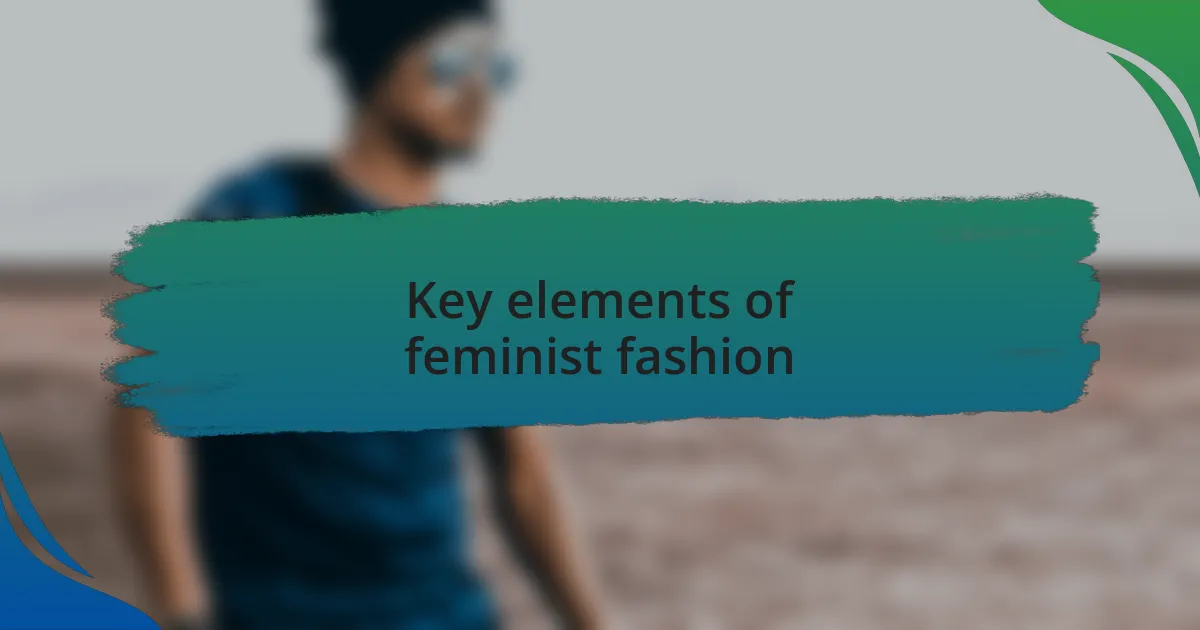
Key elements of feminist fashion
When discussing key elements of feminist fashion, one significant aspect is the celebration of individuality. I remember when I first embraced a style that truly reflected who I am rather than what was mainstream. It was a liberating experience, affirming that fashion can serve as a canvas for self-expression, allowing each person to reclaim their identity in a world full of stereotypes.
Another vital element is the commitment to inclusivity. During a recent visit to a fashion fair, I was struck by brands showcasing adaptive clothing for individuals with disabilities. It made me reflect on how fashion has the power to unite diverse bodies and experiences. Shouldn’t every garment be accessible, allowing everyone to participate in this vibrant dialogue of style?
Sustainability also plays a crucial role in feminist fashion today. I recall feeling proud when I discovered a local brand that used eco-friendly materials and promoted fair labor practices. This awareness has heightened my sense of responsibility; it makes me ponder how our consumption habits can either uplift or exploit marginalized communities. By prioritizing sustainable practices, we can redefine fashion as an empowering tool for collective change.
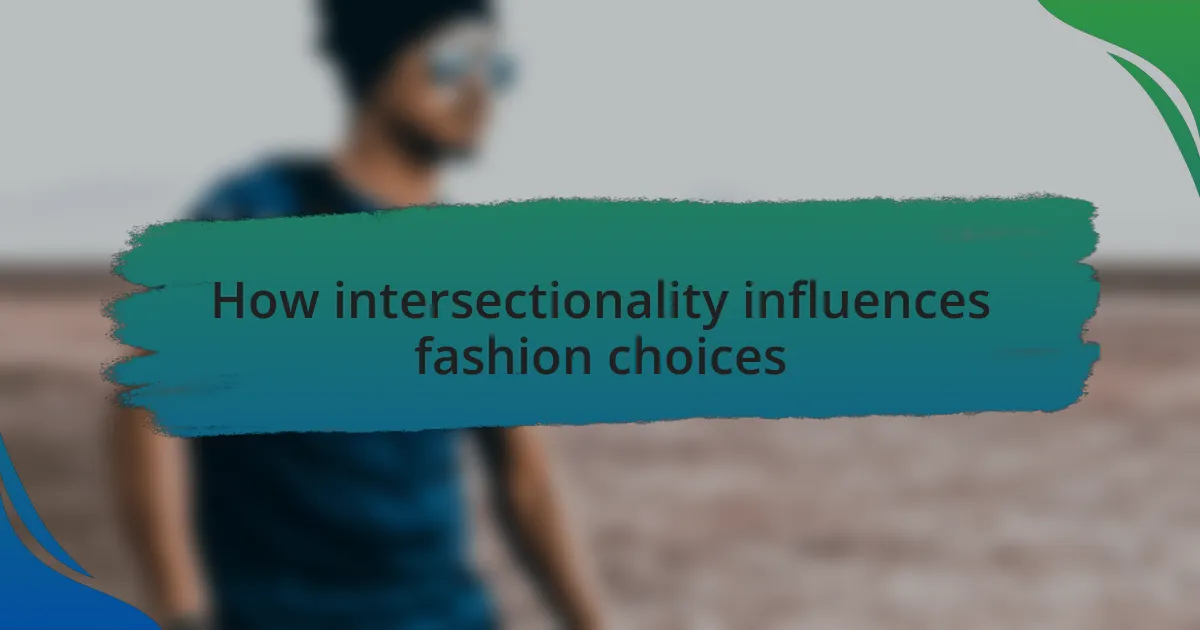
How intersectionality influences fashion choices
Understanding how intersectionality influences fashion choices reveals a complex interplay of identity. For me, finding a style that resonates with both my cultural background and feminist values has been transformative. I’ve often wondered, how can one dress without acknowledging the layers of race, gender, and socioeconomic status? Each garment feels like a statement—reflecting not just personal taste, but also an acknowledgment of the narratives woven into our clothing.
When I experience the richness of different cultural styles, I feel a blend of pride and responsibility. I vividly remember attending a gathering where women showcased traditional outfits that spoke to their heritage. It struck me how these choices often intertwine with political statements about representation and visibility. Each fabric, each design tells stories of resilience and history. This made me realize that every choice is laden with meaning—who is represented, who is excluded, and how we can honor these voices through our fashion choices.
Moreover, I’ve noticed how accessibility continues to shape fashion dialogues. A dear friend of mine, who has a disability, expressed her frustration over the lack of stylish options available. This conversation made me ponder: why should anyone have to sacrifice personal style for functionality? Intersectionality in fashion challenges us to push boundaries, ensuring that inclusivity is not just a buzzword but a lived reality. In every piece we choose, we can advocate for a more inclusive fashion landscape that celebrates every identity.
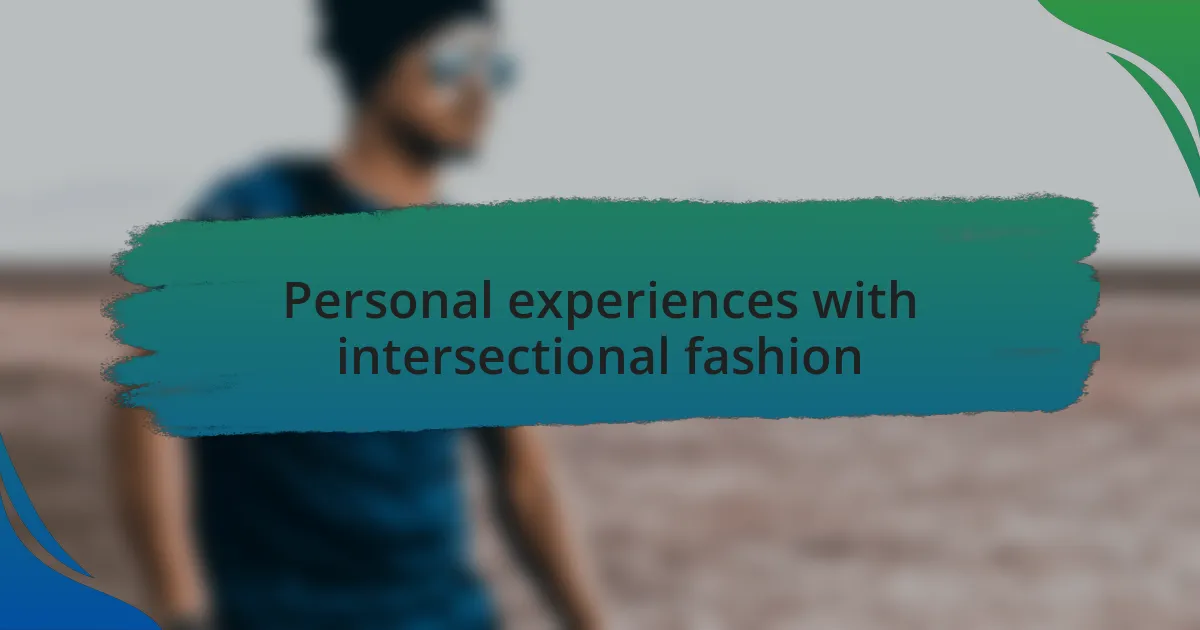
Personal experiences with intersectional fashion
Navigating the world of fashion has always felt like a dance for me, especially when my cultural identity is in the mix. I remember a time at a local fashion market where I found a vibrant, hand-stitched dress made by a local artisan. As I tried it on, I felt an innate connection to my roots—every stitch echoed the stories of women before me. It was a beautiful reminder that fashion can be a celebration of our histories while making a bold statement about who we are today.
In my quest for intersectional fashion, I’ve grappled with moments of isolation, too. I recall attending an event in a high-fashion setting, adorned in a fusion of contemporary and traditional styles. Despite feeling confident, I sensed the glances that questioned my choices. It made me realize that while I embraced the power of diverse influences, not everyone was ready to see the beauty in non-traditional aesthetics. Why should authenticity be met with skepticism? This experience deepened my commitment to showcase the myriad voices of fashion that often go unnoticed.
I often reflect on how intersectionality shapes my everyday outfits. One day, I sported eco-friendly gear that aligned with my values of sustainability while still feeling chic and stylish. It was empowering to wear something that mirrored my beliefs, but it also sparked quite a conversation with my friends about why sustainable fashion is often seen as less fashionable. How can we shift that narrative? These moments of dialogue remind me that fashion is never just about looking good; it’s a platform for broader conversations about identity, values, and the inclusivity we desperately need.
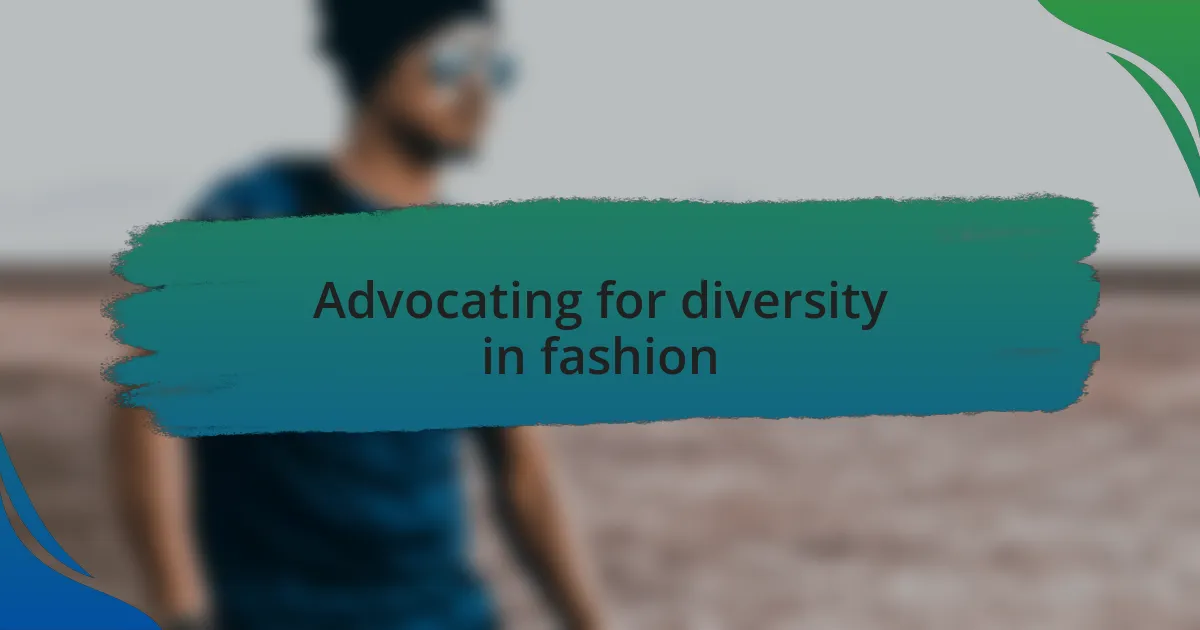
Advocating for diversity in fashion
Advocating for diversity in fashion means creating spaces where every voice is amplified. I remember a time when I attended a fashion panel focused on inclusivity. Listening to designers from different cultural backgrounds share their stories was enlightening; it made me realize that behind every piece of clothing is a narrative waiting to be told. How often do we overlook the rich experiences woven into the fabric of fashion?
In my own wardrobe, I prioritize brands that celebrate diversity—it’s a small yet impactful way to support equitable representation. I recently discovered a label that collaborates with artisans from underrepresented communities. Each piece not only highlighted exquisite craftsmanship but also sparked conversations among my friends about ethical consumption. When did clothing become just an accessory instead of a story we tell together?
I’ve often found myself reflecting on the importance of visibility in fashion. During a recent fashion show, I was thrilled to see models of all shapes and sizes strutting the runway, showcasing a diverse range of identities. It was a breath of fresh air, and it made me wonder: how can we encourage more events like this? When we celebrate all forms of beauty, we inspire others to embrace their unique styles, contributing to a richer tapestry in the world of fashion.